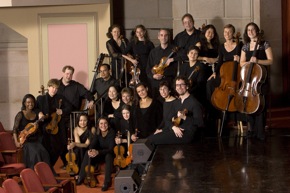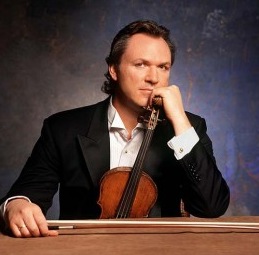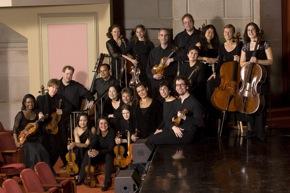
In the second season of Nadja Salerno-Sonnenberg’s tenure as its artistic director, the New Century Chamber Orchestra continues to move forward with imaginative programs highlighting, and stretching, its collective abilities. Their recent round of concerts, heard in its Herbst Theatre iteration Saturday, was in many ways a testament to the adaptability of great music in the hands of imaginative musicians. The program benefitted from the expertise of two of the great violinists of recent years, in reconceiving a variety of protean music — from Bach’s keyboard writing to Appalachian fiddle tunes.
The orchestra’s guest for this series of concerts was violinist Mark O’Connor, who is also its composer in residence for the season. O’Connor is familiar as a genre-crossing figure who brings together bluegrass fiddling, classical playing, and a host of American idioms. He’s also a dazzling, seemingly limitless virtuoso, and the evening was, as expected, a showcase for his hybrid musicianship and unbelievable chops.

O’Connor’s works on the program, written in the ’80s and ’90s, are all built very much around the soloist’s role, and all have substantial appeal. His Song of the Liberty Bell, from 1996, immediately revealed the richness and presence of his sound, as well as his sure melodic sense as a composer. His Strings and Threads Suite, written a decade earlier, is a collection of 13 vignettes that illustrate evolving American fiddle styles, starting with the Celtic reels and jigs that served as a basis for Appalachian music, and moving on through a range of African-American idioms that were developed through the 19th and 20th centuries — spirituals, blues, ragtime, swing, and so on. O’Connor has a sure hand with all the music he delved into, both as a player and as a composer, and beneath the glittering surface of his playing other elements were just as strong: the depth of his musicality, and his amazing command of intonation, whether playing it straight or bending and sliding notes as each idiom demanded.
One concern about all of O’Connor’s featured writing, and the Suite in particular, was the lack of development in the orchestral writing. The accompaniments were all fine and effective, but were exactly that, pure accompaniment, though the players seemed to be enjoying their own role as well as O’Connor’s presence. As O’Connor is now composing a new work for NCCO, to premiere in its season-closing programs in May, it should be interesting to see how he has developed his approach to writing for an ensemble with many more years behind him, not to mention a familiarity with this formidable group of players.
The program ended with Appalachia Waltz, O’Connor’s signature work, which he has recast for a number of instrumental groups. Progressing from its elegiac solo opening, this particular arrangement sensitively brought in the ensemble, giving way to a beautiful section for the low strings, and then another passage from the soloist to the full orchestra.
With an appreciative crowd on its feet, O’Connor returned for two encores, the first his Limerock, a knuckle-busting duet with Salerno-Sonnenberg, and the second a soulful, beautifully harmonized solo arrangement of Amazing Grace.
Goldberg for Gould
The program began with one of the more recent of the many reimaginings of Bach’s Goldberg Variations, in an arrangement for string orchestra by violinist and conductor Dmitry Sitkovetsky. The Variations are among the paragon examples of the famous adaptability of Bach’s music (it’s well worth hearing Uri Caine’s brilliant recording of the piece in multiple jazz styles), and they hold up quite well in Sitkovetsky’s work.
Sitkovetsky’s understanding of the piece is a contemporary one, and he dedicated his arrangement to the memory of Glenn Gould, with the intent that the string arrangement bring out some of the particular voice leading and points of emphasis in the pianist’s recordings. While Gould’s ownership of the piece is bound to inform any hearing of it (at least a little), it becomes a quite different work in this arrangement.
The arrangement uses the string orchestra’s resources astutely, with several movements given over only to the principal players in each section, creating something akin to the closeness of a string quartet or quintet. In the movements bringing out the full ensemble, the players make a rich, glorious sound, causing the sometimes austere keyboard work to seem like another Brandenburg Concerto. When Sitkovetsky cannily treats the solo players like the concertino group in a concerto grosso — removing, then bringing back, the full orchestra in alternation with the soloists — the connection to Bach’s larger ensemble works is most explicit; the approach is remarkably effective in transforming the familiar work into something new.
The orchestra sounded wonderful throughout, and special attention must be given to the section leaders who handled their virtuosic parts with grace and intensity: Sonnenberg, second violinist Candace Guirao, violist Anna Kruger, and cellist Susan Babini, along with NCCO’s sole bassist, Kristin Zoernig, who held down this role with aplomb.
Heard as a whole, some of the work’s probing intimacy, familiar from the keyboard version (and from Gould’s playing in particular), seemed missing at times. But the more extroverted character the work takes on in this version is also a reminder of the grandeur of Bach’s conception, the way in which the keyboard can be a window into the soul in one variation and an orchestra in miniature in the next.

